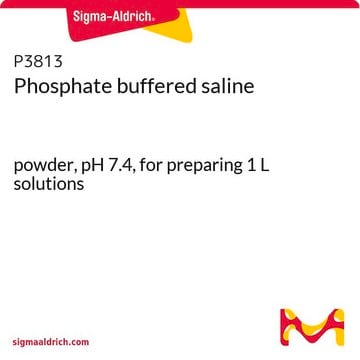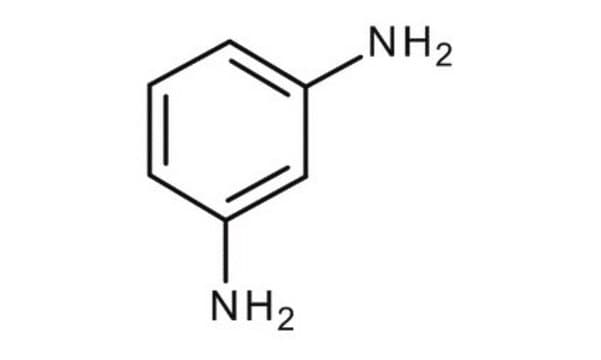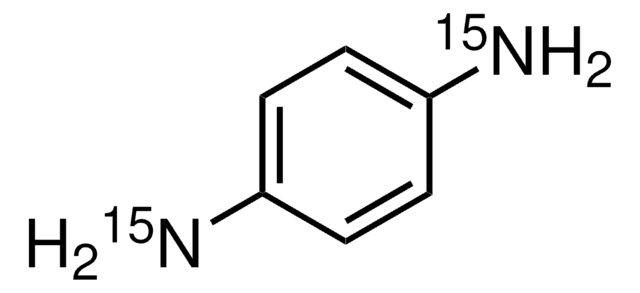We have no information on using this product for oxidase test. Product No. T3134, N,N,N′,N′-Tetramethyl-p-phenylenediamine dihydrochloride is commonly used to perform the oxidase test for the colorimetric identification of pathogenic and non-pathogenic bacteria.
Wichtige Dokumente
P6001
p-Phenylendiamin
98% (GC)
Synonym(e):
1,4-Benzoldiamin, 1,4-Diamino-benzol, p-Phenylendiamin
Größe auswählen
Größe auswählen
About This Item
Empfohlene Produkte
Dampfdichte
3.7 (vs air)
Dampfdruck
1.08 mmHg ( 100 °C)
Beschreibung
anti-fade reagent
Assay
98% (GC)
bp
267 °C (lit.)
mp (Schmelzpunkt)
138-143 °C (lit.)
SMILES String
Nc1ccc(N)cc1
InChI
1S/C6H8N2/c7-5-1-2-6(8)4-3-5/h1-4H,7-8H2
InChIKey
CBCKQZAAMUWICA-UHFFFAOYSA-N
Suchen Sie nach ähnlichen Produkten? Aufrufen Leitfaden zum Produktvergleich
Verwandte Kategorien
Anwendung
Biochem./physiol. Wirkung
Vorsicht
Signalwort
Danger
Gefahreneinstufungen
Acute Tox. 3 Dermal - Acute Tox. 3 Inhalation - Acute Tox. 3 Oral - Aquatic Acute 1 - Aquatic Chronic 1 - Eye Irrit. 2 - Skin Sens. 1 - STOT SE 1 Oral
Zielorgane
Kidney,Heart,Musculo-skeletal system
Lagerklassenschlüssel
6.1C - Combustible acute toxic Cat.3 / toxic compounds or compounds which causing chronic effects
WGK
WGK 3
Flammpunkt (°F)
230.0 °F - closed cup
Flammpunkt (°C)
110 °C - closed cup
Persönliche Schutzausrüstung
Eyeshields, Faceshields, Gloves, type P2 (EN 143) respirator cartridges
Hier finden Sie alle aktuellen Versionen:
Besitzen Sie dieses Produkt bereits?
In der Dokumentenbibliothek finden Sie die Dokumentation zu den Produkten, die Sie kürzlich erworben haben.
Kunden haben sich ebenfalls angesehen
-
May I ask if I can use P- phenylenediamine for oxidase test
1 answer-
Helpful?
-
-
What is the solubility of p-Phenylediamine, Product P6001?
1 answer-
This product is soluble in ethanol at a concentration of 50 mg/mL, with heating. A clear red to brown solution is observed.
Helpful?
-
-
What is the Department of Transportation shipping information for this product?
1 answer-
Transportation information can be found in Section 14 of the product's (M)SDS.To access the shipping information for this material, use the link on the product detail page for the product.
Helpful?
-
-
For what applications is p-Phenylediamine, Product P6001, used?
1 answer-
This is an antifade reagent that is used as a fluorescent stabilizer. Do not confuse the p-phenylenediamine with o-phenylenediamine, which is used as a peroxidase substrate in ELISA procedures.
Helpful?
-
-
What is the working concentration for p-Phenylediamine, Product P6001, when used as an antifade agent?
1 answer-
J. Immunological Methods, 43, 349 (1981) describes a solution that will reduce the fading of fluorescent materials. The recipe for this solution is: "Add 10 mL of phosphate-buffered saline (0.01 M PO4, pH 7.4 in 0.15 M NaCl) containing 100 mg of p-phenylenediamine to 90 ml of glycerol. The final pH should be adjusted to approximately 8.0 with 0.5 M carbonate-bicarbonate buffer (pH 9.0)".
Helpful?
-
Active Filters
Unser Team von Wissenschaftlern verfügt über Erfahrung in allen Forschungsbereichen einschließlich Life Science, Materialwissenschaften, chemischer Synthese, Chromatographie, Analytik und vielen mehr..
Setzen Sie sich mit dem technischen Dienst in Verbindung.












